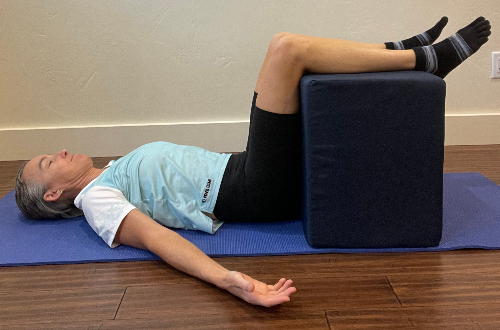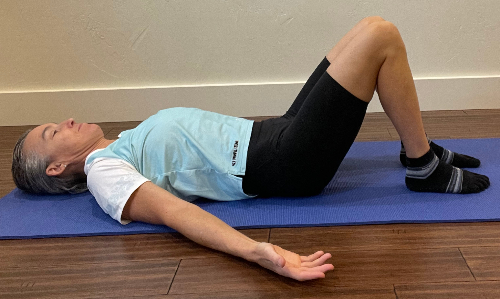The Best Position to Relieve Back Pain
Oct 10, 2018
As you might know, back pain is often the result of excess tension in the muscles that run down either side of the spine, a twisted pelvis, and tight hip flexors. Relieving this imbalance can be as easy as lying down on your back in an aligned position and breathing. This posture is known in the Egoscue Method© as Static Back. It’s commonly referred to as the 90-90 position—and it is incredibly healing.

Proper Positioning
- First, find a chair, couch, bed, table or ottoman for this technique.
- While in the position, ensure that your hips and knees are in direct vertical alignment with each other and at right angles to your torso and lower legs.
- NOTE: If your hips and legs are rotating out to the sides, your legs are too low. This will result in an ineffective exercise. In order to fix this, use blankets or pillows under your lower legs (calves and ankles) to reach the correct height.
- Also, depending on the position of your upper body, your head may not comfortably rest on the floor. If this is the case, use pillows to support your head and neck. With time, though, you should be able to reduce the support needed. Gradually use thinner pillows, blankets and towels until your head easily contacts the ground without tipping back or creating tension in your neck, shoulders or upper back.
Maintain Body Awareness
- Once you are in position, relax with your arms out to the sides, palms up.
- Here, notice how your pelvis and lower back are touching the ground.
- Meanwhile, become aware of how your shoulder blades are hitting the floor.
- Also, pay attention to the position and tension in your neck, and feel your head supported by the ground.
Now, ask yourself the following questions:
- Do I feel balanced with equal contact on both sides of my body--from my pelvis to my head?
- Also, does one side of my body feeling lighter or lifted?
- Additionally, is the tension equal throughout the muscles on either side of my spine?
- Finally, is my head tilted to one side? (You might have someone else look.)
Here's an example: when I started practicing this position, I would notice that my right lower back was much higher and tighter than my left. The tightness caused the right side of my pelvis to barely touch the ground. Not surprisingly, my back pain was most severe on my right side.
Now, Relax and Breathe
- This is a static position where you allow gravity and your breath to bring your body back into balance. In other words, you do not need to actively “DO” anything. Instead, you need to “BE” patient and allow your body the opportunity to reposition.
- While you're in the position, observe your breathing. Focus on initiating the movement from your diaphragm. Breathe throughout your entire torso - front, back and both sides. For a refresher on diaphragm breathing, watch my video:
- Depending on your starting position, it may take a while for your body to release and realign. You want to stay in this position until your entire back (side to side and head to pelvis) are equally flat and contacting the ground.
In the beginning it would take upwards of 45 minutes for my body to adjust. Clearly, I was heavily ingrained in my twisted posture. As I did the position regularly (daily is ideal), though, the time it took my body to align reduced. At the same time, my back pain started to subside. In other words, as I reminded my muscles to lengthen, and as I regularly repositioned my body, I was making long-term changes.

Alternate Position
If you don’t have something to put your legs up on, try the hooklying or constructive rest position instead.
- First, lie on your back with your knees bent at 90 degrees.
- Be sure that your legs are hip width apart and your feet are straight, fully contacting the floor from the big toes to the heel.
- Next, check that you relax your upper body. Place your palms up.
- Extend your neck, and slightly tuck your chin in toward the chest. (Use support under your neck or head if you need to. In other words, you should not be uncomfortable here.)
- Now, diaphragm breathe in this position. Allow all of the tension in your body to release as your pelvis realigns, hip flexors lengthen, and back flattens into the ground.
Repositioning and releasing excess tension is the first step in relieving back pain for good. The next step is to strengthen this improved position. Watch for my next blog where you’ll discover some of these strengthening exercises.
Stay connected with news and updates!
Join our mailing list to receive the latest news and updates from me.
Don't worry, your information will not be shared.
We hate SPAM. We will never sell your information, for any reason.

